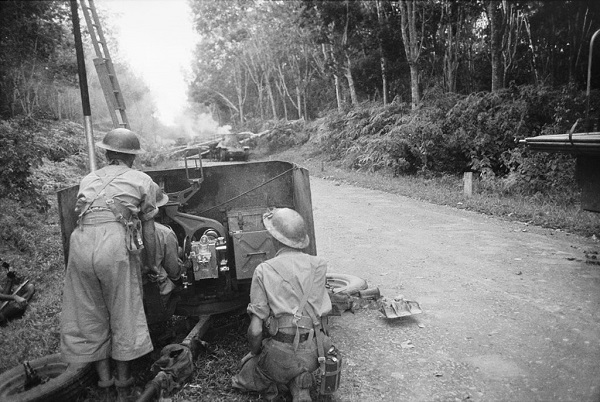80 years since Australia’s involvement in the Pacific War
Over the past few months, Australians around the nation have paused to remember a series of momentous 80th anniversaries, as the frontline reached our shores during the Second World War.
From the initial attacks on Malaya in December 1941, it took Japan just 70 days to overrun the British Empire forces and capture Singapore.
The first major engagement between Australian and Japanese troops in Malaya was the Battle of Gemas on 14 January. The last major battle of the Malayan campaign was the Battle of Muar River (14–22 January). Following this, some 150 severely wounded Australian and Indian soldiers forced to be left behind in the desperate Allied withdrawal were executed at Parit Sulong (pictured) on 22 January in what is thought to be one of first such massacres of Allied prisoners of war in Malaya.

Moving swiftly through Malaya, the Japanese reached the outskirts of the British ‘island fortress’ of Singapore in late January. There was fierce fighting on the island, but British forces were poorly led and the defence was disorganised.
Later that month, an Australian battalion with ancillary support elements – ‘Gull Force’ – was sent to protect the small island of Ambon (in present-day Indonesia) alongside Netherlands East Indies troops. Ill-prepared, under-equipped and without air support, they were overwhelmed and forced to surrender on 3 February 1942.
Singapore was surrendered on 15 February 1942 and more than 100,000 British and Commonwealth troops, including some 15,000 Australians, became prisoners of war.
In the days prior to the Fall of Singapore, thousands of civilians were evacuated, including Australian Army nurses who boarded ships bound for Australia. The last nurses to leave were the 65 who boarded the SS Vyner Brooke on 12 February 1942.
Two days out of Singapore, the Vyner Brooke was bombed and sunk by the Japanese. After many hours in the water, one group of 22 nurses made it to Radji Beach on Bangka Island, where survivors from other allied vessels sunk were found.
Captured by the Japanese on 16 February, this group of nurses were ordered to wade into the sea, where they were machine-gunned. Just one nurse, Sister Vivian Bullwinkel, survived – she would again be taken prisoner some 12 days later and managed to survive the war and return to Australia. See also Radji Beach commemoration.
On 27 February, the Australian light cruiser HMAS Perth was part of an Allied fleet of 14 Dutch, American and British ships that fought a Japanese invasion fleet at the Battle of the Java Sea. That battle was a disastrous defeat for the Allies, with nine of the ships being lost that day or in the days that followed.
The next day, two surviving ships, HMAS Perth and USS Houston, were headed towards the south coast of Java, where they encountered another powerful Japanese invasion fleet. On 28 February, the Perth was lost along with more than 350 of the ship’s company of some 680 men in the Battle of Sunda Strait. Of the Perth’s survivors, 106 would die while prisoners of war. Only 214 men from the ship’s company survived the war and were repatriated home to Australia.
The Fall of Singapore from those who were there
The following quotes are from video interviews conducted over several years with men who were at the Fall of Singapore. You can listen to the full interviews on the Anzac Portal.
Bart Richardson, who served as a lieutenant with the 2/20th Australian Infantry Battalion in Malaya and Singapore, recalled how poorly fortified Singapore was when his battalion arrived.
‘When we got back on Singapore Island, there was not a strand of barb[ed] wire erected, there was not a trench dug, there was nothing. Singapore was never… an impregnable fortress.
‘We were given a piece of ground to cover by our battalion that should have been covered by the whole division.
Following the defeat of British and Commonwealth Forces, Bart Richardson became a prisoner of war (POW). He was forced to work on the Burma–Thailand Railway, including the Konyu Cutting (now Hellfire Pass), before being moved to Changi prison until his liberation in August 1945.
Alan Morris ‘Maurie’ Deed enlisted in the Royal Australian Air Force (RAAF) on 9 May 1940 aged just 17. Maurie served in Singapore as a RAAF aircraft hand and recalled being one of many young Australians who had only just finished school before joining the war effort.
‘They talk about heroes, but we were just frightened kids. Nothing else.’
Maurie recalled the relentless Japanese air raids and bombings that those stationed at Sembewang airfield endured in the lead-up to Singapore’s fall.
‘We were getting bombed all the time. As fast as we filled holes in, so the planes could take off, they’d come over and blow them up again. In the end, it was almost continuous, the bombing of the drome.
‘I know I was scared stiff. Terrified, in fact. But you had no choice, you just had to keep going.’

Lieutenant-General Percival and his party carry the Union Jack on their way to surrender Singapore to the Japanese.
